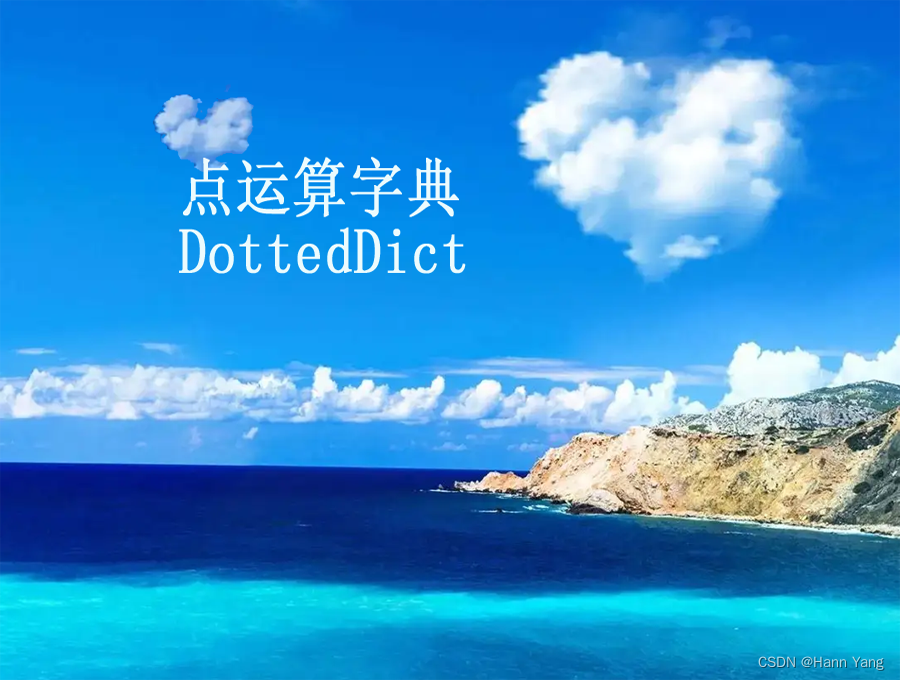DottedDict 是一种特殊的数据结构,它结合了字典(Dictionary)和点符号(Dot Notation)访问的优点,为用户提供了一种更加直观和方便的方式来处理和访问嵌套的数据。在这篇文章中,我们将深入探讨 DottedDict 的概念、实现方式、使用场景以及它在数据处理中的优势。
什么是 DottedDict?
DottedDict 是一种允许用户通过点符号来访问嵌套键值对的数据结构。在传统的字典中,如果需要访问一个嵌套的值,用户通常需要通过键来逐层访问,例如 data['outer_key']['inner_key']。而使用 DottedDict,用户可以直接通过点符号来访问,如 data.outer_key.inner_key,这种方式更加直观和易于理解。
DottedDict 的安装
C:\Users>pip install dotteddict
Looking in indexes: https://pypi.tuna.tsinghua.edu.cn/simple
Collecting dotteddict
Downloading https://pypi.tuna.tsinghua.edu.cn/packages/e5/80/2b0f5c84f4f56f96f4cb03470379b0f5827b68e75ec9df47b7d6497f6fad/dotteddict-2016.3.11.tar.gz (3.1 kB)
Preparing metadata (setup.py) ... done
Building wheels for collected packages: dotteddict
Building wheel for dotteddict (setup.py) ... done
Created wheel for dotteddict: filename=dotteddict-2016.3.11-py2.py3-none-any.whl size=3275 sha256=8905f8c47622a8c1149c24871afc1b77899d6bd19fc486807f90773a2ac688b6
Stored in directory: c:\users\boyso\appdata\local\pip\cache\wheels\94\04\da\3e3aa22786fbbe407327f8d3da5580592217bdf16e4d2d9070
Successfully built dotteddict
Installing collected packages: dotteddict
Successfully installed dotteddict-2016.3.11
DottedDict 的实现方式
DottedDict 的实现通常依赖于面向对象编程中的属性访问机制。在 Python 中,可以通过定义一个类,并重载 _getattr__ 方法来实现 DottedDict 的行为。当用户尝试访问一个属性时,__getattr__ 方法会被调用,并在其中查找相应的键值对。如果找到了,就返回对应的值;如果没有找到,就抛出一个属性不存在的错误。
例如,以下是一个简单的 DottedDict 实现:
class DottedDict:def __init__(self, data):self._data = datadef __getattr__(self, item):# 如果项是字典类型,则返回 DottedDict 对象以便继续使用点符号if isinstance(self._data.get(item), dict):return DottedDict(self._data.get(item))else:return self._data.get(item)# 使用示例
data = DottedDict({'outer_key': {'inner_key': 'value'}})
print(data.outer_key.inner_key) # 输出: valueDottedDict 的使用场景
DottedDict 在处理配置文件、解析 JSON 数据或者在任何需要处理嵌套数据的场景中都非常有用。例如,在配置文件中,经常会有多层的设置,使用 DottedDict 可以方便地读取和修改这些设置,而不需要编写复杂的访问函数。
DottedDict 的优势
- 直观性:通过点符号访问嵌套数据,使得代码更加易读和易于维护。
- 简洁性:减少了访问嵌套数据时所需的代码量,使得代码更加简洁。
- 灵活性:DottedDict 可以轻松地与其他数据结构结合使用,如列表和元组,提供了更多的数据处理可能性。
- 错误友好:当尝试访问不存在的键时,DottedDict 会抛出错误,这有助于及时发现和修复问题。
DottedDict 的基本用法
| For example:
|
| data = {"people": {"bob": {"status": True}, "john": {"status": False}}}
| dotted = dotteddict(data)
| dotted.people.bob.status
| dotted["people.john.status"]
|
| This is in contrast to using defaults:
|
| dotted["people"]["john"]["status"]
创建对象
使用普通字典创建 DottedDict 对象:
from dotteddict import dotteddict# 使用字典创建
data = dotteddict({"name": "Alice", "age": 30})访问元素
使用点号访问 DottedDict 元素:
print(data.name) # 输出:Alice
print(data.age) # 输出:30修改元素
同样使用点号修改元素:
data.age = 31
print(data.age) # 输出:31嵌套字典
DottedDict 支持嵌套字典,我们可以像访问对象属性一样访问嵌套元素:
data = DottedDict({"user": {"name": "Charlie", "age": 28}})
print(data.user.name) # 输出:Charlie
print(data.user.age) # 输出:28其他操作
DottedDict 支持大部分字典操作,例如:
| clear(...)| D.clear() -> None. Remove all items from D.|| copy(...)| D.copy() -> a shallow copy of D|| items(...)| D.items() -> a set-like object providing a view on D's items|| keys(...)| D.keys() -> a set-like object providing a view on D's keys|| pop(...)| D.pop(k[,d]) -> v, remove specified key and return the corresponding value.|| If the key is not found, return the default if given; otherwise,| raise a KeyError.|| popitem(self, /)| Remove and return a (key, value) pair as a 2-tuple.|| Pairs are returned in LIFO (last-in, first-out) order.| Raises KeyError if the dict is empty.|| setdefault(self, key, default=None, /)| Insert key with a value of default if key is not in the dictionary.|| Return the value for key if key is in the dictionary, else default.|| update(...)| D.update([E, ]**F) -> None. Update D from dict/iterable E and F.| If E is present and has a .keys() method, then does: for k in E: D[k] = E[k]| If E is present and lacks a .keys() method, then does: for k, v in E: D[k] = v| In either case, this is followed by: for k in F: D[k] = F[k]|| values(...)| D.values() -> an object providing a view on D's values使用实例
from dotteddict import dotteddict# 假设我们有一个用户的嵌套信息字典
user_info = {"personal": {"name": "Charlie","age": 28,"location": {"city": "San Francisco","country": "USA"}},"contact": {"email": "charlie@example.com","phone": "555-0199"},"preferences": {"language": "English","theme": "Dark"}
}# 使用 DottedDict 来包装这个嵌套字典
user = dotteddict(user_info)# 现在我们可以方便地访问用户信息
print(f"User Name: {user.personal.name}")
print(f"Age: {user.personal.age}")
print(f"Location: {user.personal.location.city}, {user.personal.location.country}")
print(f"Email: {user.contact.email}")
print(f"Phone: {user.contact.phone}")
print(f"Preferred Language: {user.preferences.language}")
print(f"Theme: {user.preferences.theme}")# 我们也可以修改用户信息
user.personal.age = 29
user.contact.phone = "555-0199-1234"# 甚至可以添加新的嵌套信息
user.education = dotteddict({"highest_degree": "Master's","field_of_study": "Computer Science"
})# 展示修改和新增的信息
print(f"Age (updated): {user.personal.age}")
print(f"Phone (updated): {user.contact.phone}")
print("Education Info:")
print(f"Highest Degree: {user.education.highest_degree}")
print(f"Field of Study: {user.education.field_of_study}")
结论
DottedDict 是一种强大的数据结构,它通过提供点符号访问机制,极大地简化了处理嵌套数据的过程,让字典操作更加直观和优雅,让代码变得更加 pythonic。

目录
什么是 DottedDict?
DottedDict 的安装
DottedDict 的实现方式
DottedDict 的使用场景
DottedDict 的优势
DottedDict 的基本用法
创建对象
访问元素
修改元素
嵌套字典
其他操作
结论
完
,附有道云笔记链接)









![VScode配置launch+tasks[自己备用]](http://pic.xiahunao.cn/VScode配置launch+tasks[自己备用])




——图片卷积)



